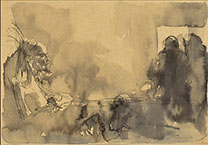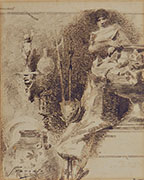(Ferrara 1852 - Lavagna 1920)
RENZO AND FRA CRISTOFORO VISIT THE DYING DON RODRIGO (I Promessi Sposi, Chapter XXXV)
Black chalk, signed Previati lower right. The whole sheet (380 x 309 mm) was glued to the passe-partout with adhesive tapes. Dimensions to the image 272 x 200 mm.
Previati had begun to make drawings inspired by Alessandro Manzoni’s masterpiece, I Promessi Sposi in the late 1880s. Previati continued off and on to draw subjects inspired by Manzoni’s novel until July of 1895, when the publisher Hoepli announced a competition for a newly illustrated edition of the book. Previati’s victory over the thirteen other contestants (including Giovanni Fattori) was announced on the 6th of January 1896. The new edition ofI Promessi Sposi was issued in instalments from 1897 to 1900. After the publication of the book, Previati’s drawings remained the property of the publisher Hoepli. It was not until the 1920s that they were purchased by the Milanese city government and are now part of the collections in the Castello Sforzesco. Previati, however, made more than one copy of some of the illustrations, and these have appeared in exhibitions and sales. There is another version of this drawing, substantially identical, in the collections of the Castello Sforzesco.
Born into a pious family in Ferrara, Previati was predisposed toward the spiritual in art. He first enrolled in the Ferrarese academy in 1870. In 1876, he was in Florence where he studied with Cassioli, and the following year he was in Milan where he took courses at the Brera from Bertini. At first, Previati painted historical subjects in a romantic but naturalistic style. Later, under the influence of Morelli, Cremona and the Scapigliati, he developed a freer, more personal style characterized by a patterned impasto and dramatic light. He also studied the works of Rossetti and other Pre-Raphaelites and created overtly spiritual subjects. In the 1880s, Previati designed fourteen illustrations inspired by the writings of Edgar Allan Poe, a project that brought him in contact with Symbolism, and he was influenced by Félicien Rops, Gustave Moreau and Redon as well as writers of the movement. Around 1889, Previati met Vittore Grubicy who served as a catalyst in the artist’s adoption of Divisionism. Alberto Grubicy, Vittore’s brother, held a contract to sell Previati’s work as well as that of Segantini. In 1891, Previati exhibited 'Motherhood' at the Brera 'Triennale', now famous as the first Italian Symbolist exhibition and as the exhibition which introduced Divisionism. A year later, in 1892, Previati exhibited in Paris at Durand-Ruel through his association with Joseph Péladan’s Rose-Croix. Previati was an intellectual who believed that the world was entering a new age and that he needed to prepare other artists. To that end he wrote several books on theory and technique of painting.


